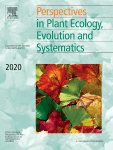Ver ítem
- xmlui.general.dspace_homeCentros e Institutos de InvestigaciónCIAP. Centro de Investigaciones AgropecuariasInstituto de Fisiología y Recursos Genéticos VegetalesArtículos científicosxmlui.ArtifactBrowser.ItemViewer.trail
- Inicio
- Centros e Institutos de Investigación
- CIAP. Centro de Investigaciones Agropecuarias
- Instituto de Fisiología y Recursos Genéticos Vegetales
- Artículos científicos
- Ver ítem
Volcanism rather than climatic oscillations explains the shared phylogeographic patterns among ecologically distinct plant species in the southernmost areas of the South American Arid Diagonal
Resumen
Shared genetic patterns within a community of ecologically distinct species may reflect the role of past geoclimatic events imprinting species evolutionary history. Although Pleistocene glaciations are the most important processes evoked as drivers of these shared patterns, in some regions Quaternary volcanic activity should also be considered as a potential process shaping genetic diversity distribution. Additionally, phenotypic attributes related to
[ver mas...]
Shared genetic patterns within a community of ecologically distinct species may reflect the role of past geoclimatic events imprinting species evolutionary history. Although Pleistocene glaciations are the most important processes evoked as drivers of these shared patterns, in some regions Quaternary volcanic activity should also be considered as a potential process shaping genetic diversity distribution. Additionally, phenotypic attributes related to dispersal and persistence may affect the time and manner in which species respond to geoclimatic changes. We performed a comparative phylogeographical study within a plant community of the South American Arid Diagonal to assess whether genetic patterns are better explained by climatic changes or volcanisms, taking into account the possible influence of life form and dispersal syndromes of the focal species. Chloroplast intergenic spacers were sequenced for five plant species. Genealogy, divergence time estimates, demographic and range expansion analyses were performed. Approximate Bayesian Computation was used to test plausible shared phylogeographic scenarios. Climatically stable areas during the last glacial period were inferred with distribution modeling. Results showed that most species were split into northern and southern lineages separated by a phylogeographic break at around 37.5 °S, with the northern populations being genetically less diverse, inhabiting both climatically stable and unstable areas, but being severely affected by intense Plio-Pleistocene magmatic activity; the southern populations, less influenced by volcanism, appeared to be genetically more diverse and occupied climatically stable areas through time. Most recent range expansions and effective population size increases occurred after most of the volcanic episodes, before and during the Last Glacial Maximum. All species shared the same geographic origin of the detected spatial expansion. Overall, our results suggest a preponderant effect of Quaternary volcanism rather than climatic oscillations on the evolutionary history of this xerophytic community. Additionally, we found evidence that autecological traits would have modulated the community historical responses.
[Cerrar]

Autor
Baranzelli, Matias Cristian;
Cosacov, Andrea;
Rocamundi, Nicolás;
Issaly, Eduardo Andrés;
Aguilar, Dana Lucía;
Camps, Gonzalo Andres;
Andraca-Gómez, Guadalupe;
Petrinovic, Iván Alejandro;
Johnson, Leigh, A.;
Sérsic, Alicia Noemí;
Fuente
Perspectives in Plant Ecology, Evolution and Systematics : 125542 ( Available online 12 May 2020)
Fecha
2020-05
Editorial
Elsevier
ISSN
1433-8319
Formato
pdf
Tipo de documento
artículo
Palabras Claves
Derechos de acceso
Embargado
 Excepto donde se diga explicitamente, este item se publica bajo la siguiente descripción: Creative Commons Attribution-NonCommercial-ShareAlike 2.5 Unported (CC BY-NC-SA 2.5)
Excepto donde se diga explicitamente, este item se publica bajo la siguiente descripción: Creative Commons Attribution-NonCommercial-ShareAlike 2.5 Unported (CC BY-NC-SA 2.5)

